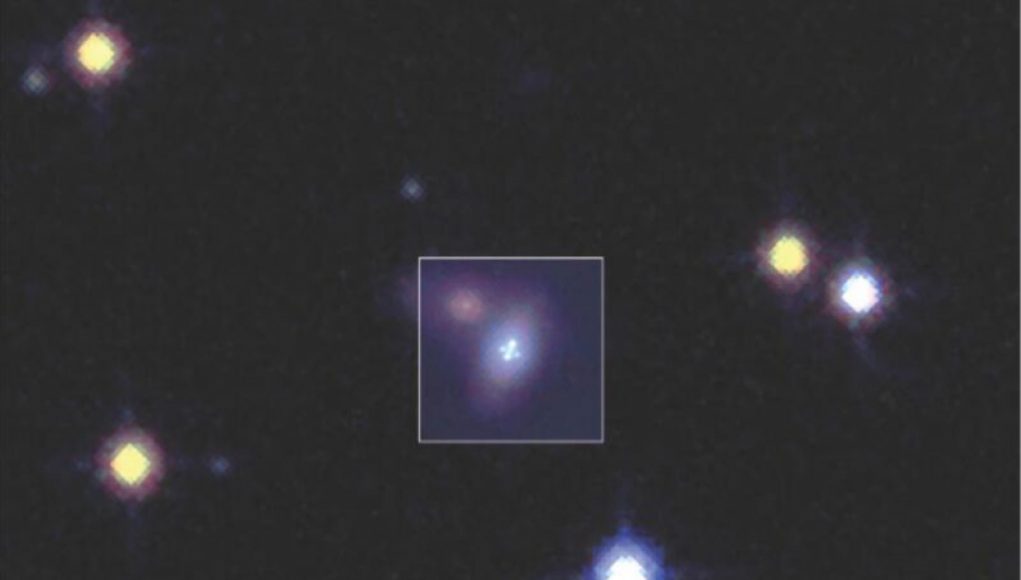Astronomers have made an incredible discovery using a cosmic magnifying glass known as “gravitational lensing.” They’ve detected a supernova explosion that was previously unknown, and it’s located more than 4 billion light-years away! The discovery was published in the journal Nature Astronomy, and co-author Ariel Goobar, director of the Oskar Klein Center at Stockholm University, called it “a significant step forward in our quest to understand the fundamental forces shaping our universe.”
Gravitational lensing is a rare phenomenon that occurs when mass bends and warps spacetime, causing light to follow that curvature. This can create effects like an “Einstein ring” or an “Einstein cross.” Essentially, the distortion in space-time caused by a massive object acts as a lens to magnify an object in the background. While these lenses aren’t perfect, they can help astronomers spot celestial objects that might otherwise be too faint or far away to see.
Last year, astronomers analyzed a Hubble image from 2010 and discovered a supernova that had been captured at three different locations within Hubble’s field of view. Thanks to gravitational lensing, researchers were able to piece together the time course following the supernova, even though it had been observed over a decade earlier.
This latest discovery centers on a newly discovered supernova called SN Zwicky, which was detected at the Zwicky Transient Facility (ZTF). The ZTF is a robotic camera attached to the 70-year-old Samuel Oschin telescope at the Palomar Observatory in San Diego County. It scans the entire sky over three nights and the visible plane of the galaxy twice every night, looking for objects that erupt or vary in brightness.
Astronomers quickly realized that SN Zwicky was of interest because it was so unusually bright. They relied upon the adaptive optics instruments at three other telescopes—the W.M. Keck Observatory, the Very Large Telescope, and the Hubble Space Telescope—to view four images of the object from different positions in the sky. This confirmed that the supernova’s unusual brightness was a product of gravitational lensing. This discovery has the potential to answer many questions about the fundamental forces shaping our universe.
A serendipitous discovery in the depths of space may lead to special insight into the nature of the universe at its most fundamental level. An international team of scientists have recently discovered a type of supernova nicknamed a “lensed” supernova, triggered by a phenomenon known as gravitational lensing. This phenomenon has created a rare cosmic effect that has allowed for a closer examination of the behavior of the universe’s fundamental forces.
Gravitational lensing occurs when a massive object, such as a galaxy, lens the light of another object behind it, magnifying its appearance. This is the case with the supernova in question, as it was discovered in the Bulge of galaxies in the constellation of Pegasus. The light from the supernova was magnified by the gravity of a massive structure between it and us, causing it to appear brighter than the faintest supernovae ever discovered.
This rare lensed supernova has proven to be an invaluable astronomical source as its location in a dense part of the galaxy has allowed scientists to get an even better understanding of how the laws of physics govern the universe. Consequently, they were able to find out that its behavior seemed to be significantly more complex than of regular supernovae. The notion that this could be a new kind of supernova, which could shed light on the fundamentals of the universe, has been suggested before.
Another discovery made by the team has been that this lensed supernova was brighter than a regular supernova during the supernova event, possibly due to the mass of the intervening structure. This embedded structure can play a part in modulating the brightness of the supernova, leading to the possibility of a whole new field of supernova science.
The superb conditions of the lensed supernova present a unique opportunity to gain insight into the most basic principles of our universe. By examining the behaviors of this type of supernovae, astronomers will be able to not only gain insight into what causes them to spark and fade, but into the basic cosmological forces beneath them.
This groundbreaking discovery has the potential to revolutionize our knowledge of the universe, providing insight into the very fabric of cosmology. It’s a remarkable achievement, and could open whole new fields of astronomy and astrophysics.




















